A Private Tour today, mostly looking for Owls but also trying to catch up with a few of our other wintering specialities on the way. We were lucky that the snow which hit much of southern England overnight didn’t make it this far north. It was a grey, cold and windy start, but it brightened up through the morning and we even enjoyed some sunny intervals in the afternoon.
Hoping to catch a Barn Owl still out hunting, we headed straight down to the grazing marshes first thing. It was exposed out here, with no shelter from the wind, and we couldn’t see any sign of the Barn Owl when we arrived. But we happened to turn round just in time to get a glimpse of it flying in from the more sheltered fields behind us, on the other side of the road. It normally hunts the fields where we were standing before going to roost, but it didn’t today – it disappeared behind some bushes and didn’t come out the other side.
We walked over to the field on the other side in case we could find it still on a post, but it had obviously gone straight in to roost in one of the bushes. After several nights with a hard frost, there was surprisingly no sign of any on the grass this morning, so perhaps it hadn’t had such a hard night hunting last night and could afford to turn in early and get out of the wind. There was a big flock of Curlews in the field just beyond.
In case one of the other Barn Owls might still be out, we had a quick walk out across the grazing marshes anyway. Three Marsh Harriers hung in the air over the reeds. We could hear Bearded Tits calling, but they were sensibly keeping tucked down out of the wind. A little party of Brent Geese circled over and a small flock of Pink-footed Geese came up from the grass calling.
Thinking we would be better trying our luck elsewhere, we headed round to Blakeney. A Curlew was feeding in the harbour as we parked. We climbed up onto the seawall and scanned the marshes, but there was no sign of any Barn Owls still out here either. There was a commotion down on the bank of the duck pond, as a rowdy mob of Black-headed Gulls was squabbling over the food put out for the ducks.
One larger gull was with them. With its back a shade of grey darker then Herring and odd fleshy legs not as yellow as a Lesser Black-backed Gull, it is a hybrid between the two. It returns here each winter, to take advantage of the easy pickings around the duck pond. Something spooked all the gulls and the Lesser Black-backed x Herring Gull hybrid flew round and landing on the water in the harbour channel.

Out on the saltmarsh in the middle of the harbour, we could see a small group of Brent Geese and Wigeon. There were Lapwings here too, and through the scope we could make out several Golden Plover, very well camouflaged in amongst the browns and golds of the saltmarsh vegetation.
It was low tide so we walked up to the corner of the seawall and scanned the exposed mud. There were lots of Dunlin scuttling around, occasionally whirling round in small flocks. Several Curlew and Redshanks were scattered around more sparsely, along with one or two Grey Plover. Further out, lots of Oystercatchers were out in the middle of the harbour. A few Reed Buntings flew backwards and forwards across the path, and we flushed a Meadow Pipit from the grass. Several Marsh Harriers quartered the reeds.
It looked like the sky was starting to brighten up a fraction, and perhaps the wind had dropped just a touch. We decided to head inland to see if we could find a Little Owl out, despite the cold and windy weather. Surprisingly, we were in luck. At our first stop, we scanned some distant barns and found a Little Owl, hiding in a sheltered spot on the roof. It was a bit distant, but it was a good start.
A flock of Brent Geese flew over, heading inland from the coast. They circled round and landed in some winter wheat a couple of fields back. A quick scan through them with the scope, and we found a Pale-bellied Brent in with the regular Dark-bellied Brents. More Brent Geese flew in and circled down to join them, but just as we started to look through them again something spooked them. The whole flock flew round and landed back down again, but now they were behind a hedge and we couldn’t see the whole flock any more.
At the next set of barns, there was no sign of the Little Owl. It was a bit more exposed here. But a bit further on, we spotted another Little Owl on another group of farm buildings. A path leads down past these barns so we walked up for a closer look. There were lots of Fieldfares feeding in the grassy meadow beside the path as we passed. An adult Mediterranean Gull circled overhead, possibly wondering what on earth we were doing out on a day like today – it certainly didn’t feel very Mediterranean today! Two Brown Hares ran across the path ahead of us.
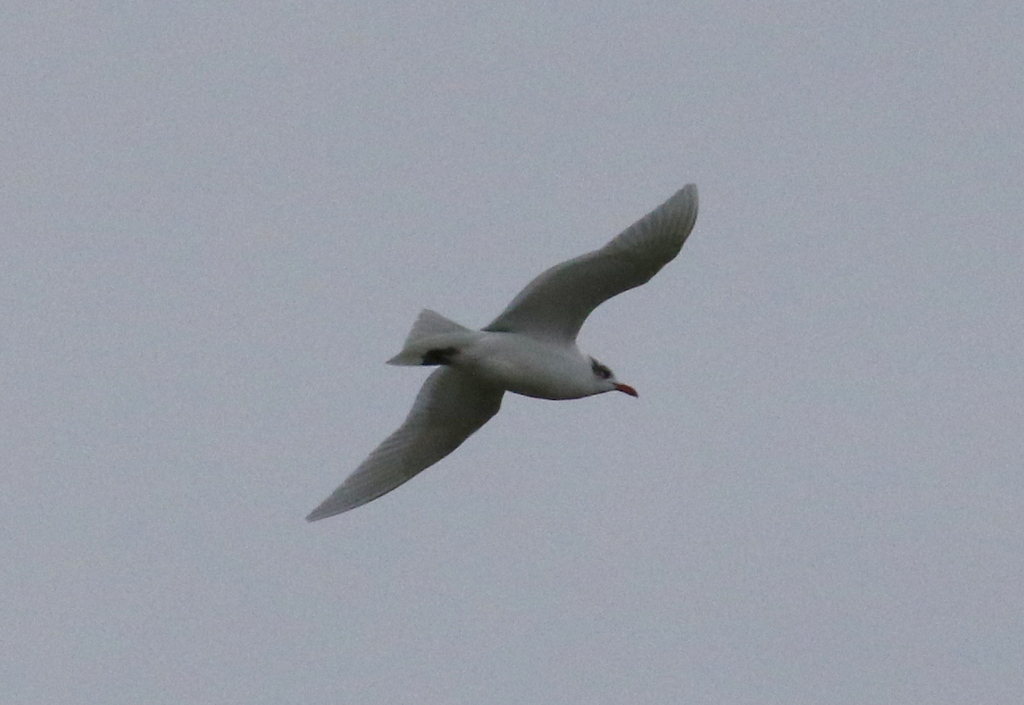
From the top of the path, we had a much better view of the Little Owl. It had found a sheltered spot, hiding under the cowl on the roof, on the side in the lee of the wind. It stared at us, but we were far enough away that we wouldn’t disturb it, and it quickly settled down and ignored us. We scanned across the roof and found a second Little Owl hiding further over, our third of the morning and a surprise to see so many out today given the cold, windy morning.
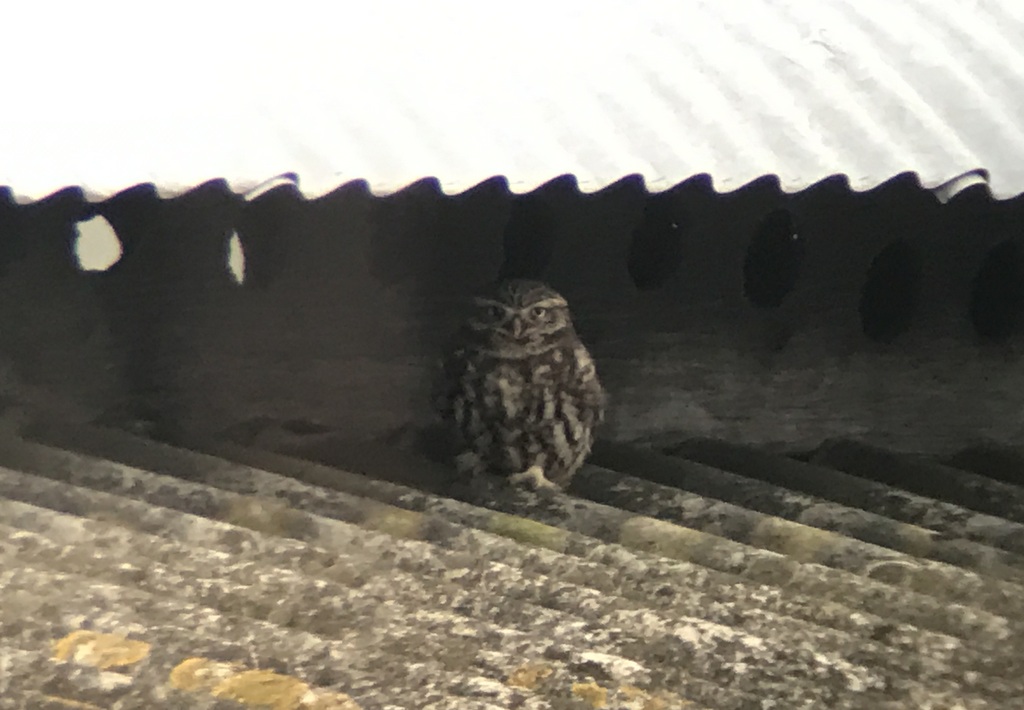
Back in the warmth of the van, we made our way back down to the coast and headed west. As we passed Holkham, we looked across to see a Great White Egret out on the marshes. Big and white, it stood out like a sore thumb. A Red Kite hung in the air over the road.
We headed straight over to Snettisham. We had a look through the Ducks on the pits on our way in. There were several Goldeneye and Tufted Ducks on the sailing club pit. Over the crossbank, and there were more Wigeon and three Little Grebes on the next pit. But we couldn’t find any sign of the Smew this morning.
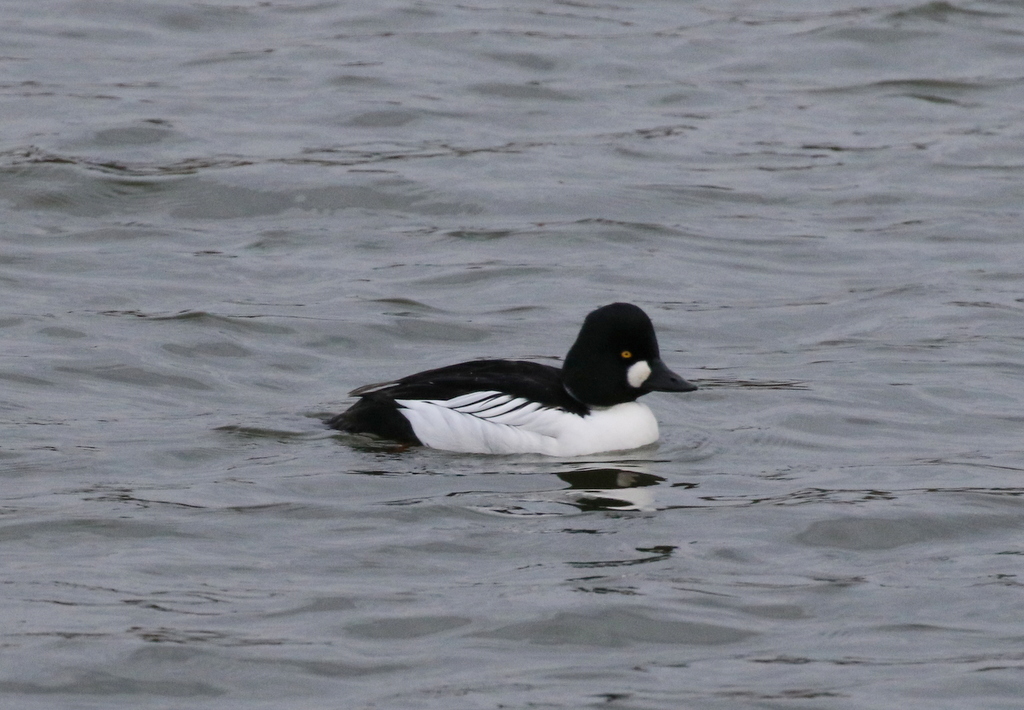
From up on the sea wall, we could see that the tide was out. A buzzard was flying towards us, over the fields on the other side of the pits. It stopped to hover – it was a Rough-legged Buzzard, we could see its white head and contrasting blackish belly. We lost sight of it as it dropped below the bank, but then it came up again further along, behind us. We could see its white tail with a clear cut black terminal band as it flew off inland.

As we walked over the causeway, we stopped again to scan the pits. We picked up a few Shoveler and some Gadwall, the latter a bit too distant to really approach the fine detail of their plumage patterns today. Two feral Barnacle Geese were feeding in the grass round on the far side, down towards South Hide.
Our main target here today was Short-eared Owl. We made our way round to a spot overlooking some bushes and stopped to scan. It didn’t take long to find our first Short-eared Owl hiding under some brambles. It has chosen a remarkably open spot in which to roost. Further on, we found a second Short-eared Owl, better hidden in some more bushes.

Something spooked all the waders out on the Wash and we looked over to see some distant flocks whirling round. With the tide out, they were a long way off today, but we did see a flock of Bar-tailed Godwits which flew in a little closer.
Moving on, we drove round to the north coast. It was almost time for lunch, but we made a quick stop Thornham Harbour. As we got out of the van, the flock of Twite flew round and dropped down into the car park for a drink at the puddles. They didn’t stop long, but flew back to the grass – and one to the bench – just beyond. Then they flew round again and landed on the saltmarsh below the seawall. Here we had a good look at them through scope – we could see their orange breasts and faces and yellow bills.

With the tide out, there were a few waders feeding down in the muddy harbour channels – several Common Redshanks, a couple of Black-tailed Godwits and Curlews. A little further out, on the mud bank in the middle of the main channel, we could see a Grey Plover and two Ringed Plovers.
Over a late lunch and a welcome hot drink at the Visitor Centre at Titchwell, we stopped to watch the feeders. There were lots of birds coming and going, a selection of finches and tits, but no sign of any Brambling while we were eating. The cloud was starting to break up now and the first rays of sun appeared through the trees.
We had been told that a Barn Owl had been hanging around in the paddocks beyond the car park earlier, but when we walked round there after lunch there was no sign of it. We couldn’t find it around Patsy’s Reedbed either. A Common Snipe was feeding in between the roosting ducks in the cut reeds at the front of the pool. More ducks were gathered on the edge of the ice at the back, including several Common Pochard.
Round via the Meadow Trail, we had a look at the Thornham grazing meadow, but it was rather more exposed this side. We did find one of the Water Rails, feeding in the wet leaves in the bottom of one of the ditches, busily flicking the leaves aside and probing into the wet mud below looking for invertebrates.
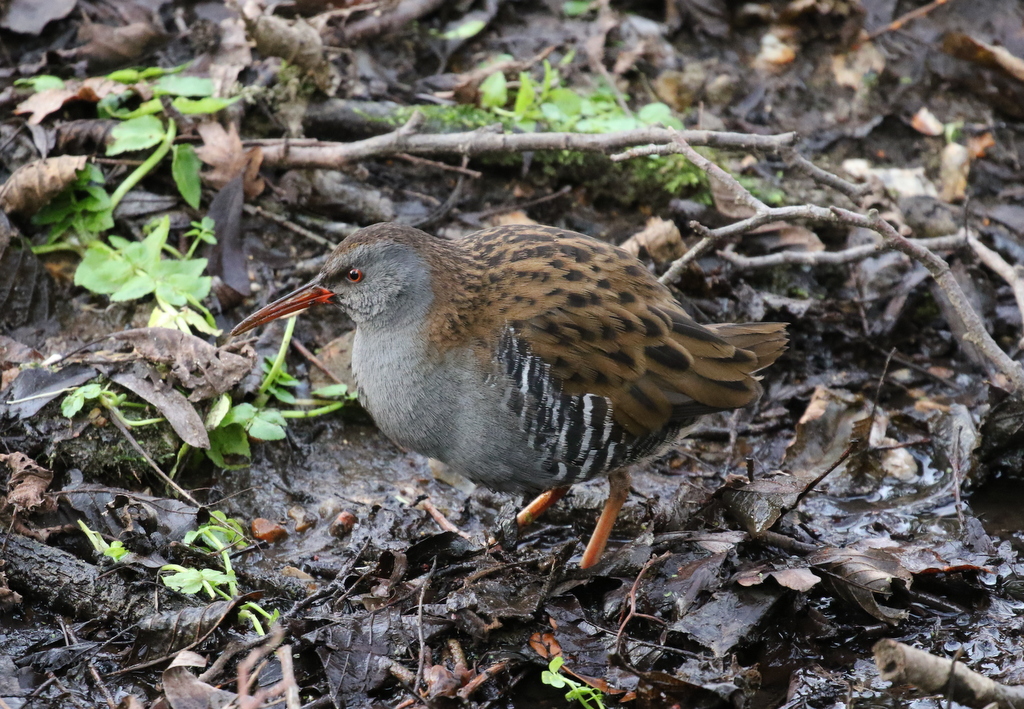
Walking back towards the Visitor Centre, a quick look at the feeders the other side produced a Brambling in the tree above. It dropped down onto one of the feeders briefly, then flew off again.
On our way back east along the coast road, we were slightly surprised no Barn Owls were out. Late afternoon is often prime time for them along here, if they are hungry, but perhaps they are still finding enough food during the night and are not feeling the need to come out too early.
A bit later than planned, we arrived at our final destination of the day. As we walked down to the water meadows, the Barn Owls were out already, but right down at far end. They were both out, male and female, and busy hunting already. One flew off across the field and over the road out of view and the other disappeared behind some trees. We walked down, thinking we might be able to find it still hunting the field margins there, but by the time we got there it had disappeared completely.
We turned to come back, thinking we may have to go for a drive to try to relocate one of them. A Water Vole showed itself briefly in the ditch beside the path to one of the group. Two Bullfinches flew out of the brambles and off across the water meadow.
Almost back to the van, one of the Barn Owls flew out of the trees ahead of us, straight towards us. It had obviously looped back round. It did a quick circuit of the grassy bank above us, then headed off down to the far end of the meadows again and disappeared from view. It was covering ground very quickly today, and didn’t seem to be stopping to hunt anywhere concertedly. Perhaps it was struggling to find food tonight? A couple of minutes later, we spotted it coming back again over the meadows. It flew right past us and off into the trees again.

We were just about to walk into the trees ourselves, thinking we might look for it over the fields the other side, when the Barn Owl reappeared. This time it landed on a post, and stopped for a rest, so finally we could get a good view of it through the scope. It hopped to a second post. Then it was off again hunting down to the far end of the meadows.
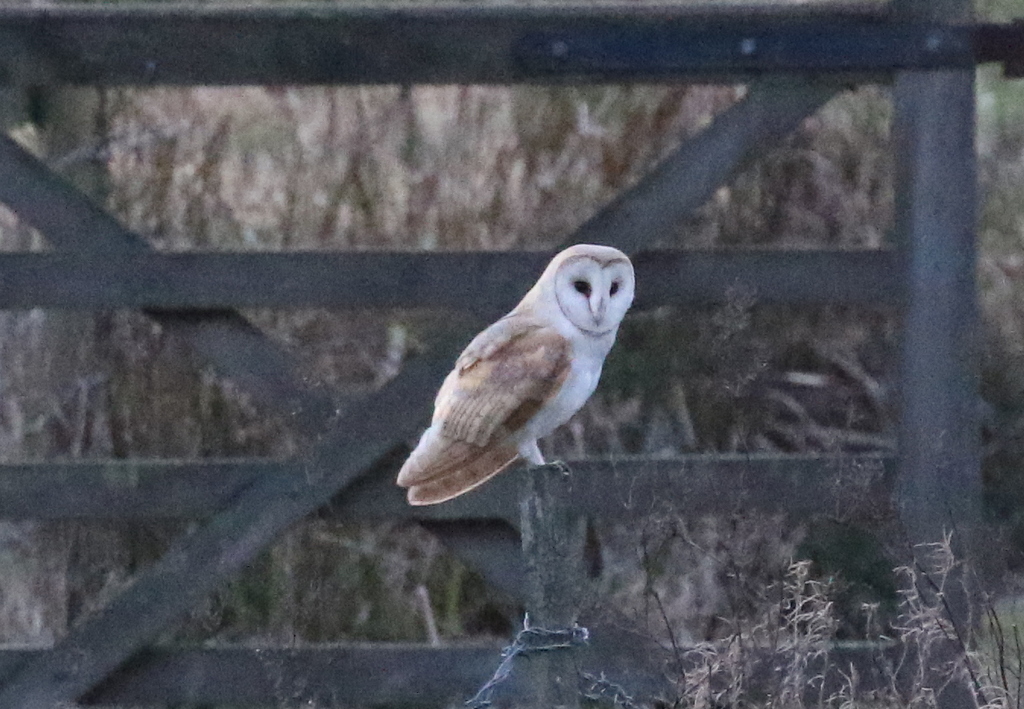
The light was starting to go now and we heard the first Tawny Owl hoot. We made our way into the trees and positioned ourselves overlooking the ivy-covered tree where the male likes to roost. The female hooted next, a more bubbling version of the male’s hoot from deeper in the trees, and then called, a sharp ‘kewick’. The male Tawny Owl answered with a hoot then dropped out of the ivy, and flew off through the trees. We could see its broad rounded wings. It landed but was hidden from view, then it was off again deeper into the wood. We could still hear both the Tawny Owls hooting further into the trees and another male answered from over the other side.
It had been a very successful day of owls, despite the cold and windy weather. Now it was time to call it a night.
















